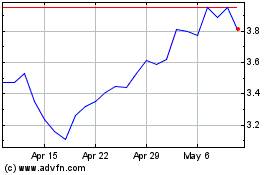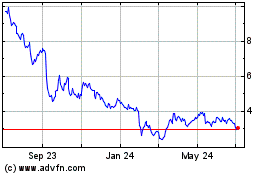Investments in Autonomous Driving Are Accelerating, says IHS Automotive
January 05 2015 - 2:00PM
Business Wire
Two Distinct Strategies Emerge as Google, Automakers Solidify
their Approach
Google and various automakers have increased their activity and
investments toward the goal of self-driving vehicles, while Google
has shifted from its previous strategy to now focus on fully
driverless vehicles for the future. If successful, it will have
significant implications for the auto industry, according to IHS
Automotive, based on findings from a new report, Autonomous
Driving: Question is When, Not If, which is an update to a previous
report issued early in 2014.
OEMs remain geared toward augmenting the driver and adding
incremental autonomous functions as autonomous driving technology
improves. These findings further support the IHS Automotive global
forecast for nearly 12 million in annual sales of self-driving cars
in 2035, and also outline longer-term opportunities, as nearly all
autos in use are likely to become self-driving cars or self-driving
commercial vehicles on some level sometime after 2050.
To help with development, many testing areas for self-driving
cars were established in 2014. Google and Mercedes-Benz began
renting space on former military bases, which have existing road
infrastructures useful for testing, and other test facilities are
emerging at the University of Michigan, Milton Keynes and three
other locations in the UK and at a Volkswagen site in Germany.
Vehicle manufacturers are working with industry organizations,
suppliers and university research conglomerates on these
efforts.
Google’s Approach: Level 5 Autonomy, Fully Self-driving
Cars
In 2014, Google adjusted its approach to focus on fully
autonomous vehicles – those that have the ability to operate
without a driver at all (also referred to as level 5, or L5). This
approach, if successful, will vastly expand the market for
vehicles, offering Car-as-a-Service (CaaS) opportunities for
business and individuals alike.
“Google’s path goes through low-speed testing of self-driving
cars in restricted areas beginning in 2015 and lasting three to
five years,” said Egil Juliussen, the report’s co-author
anddirector, research, infotainment and advanced driver assistance
systems at IHS Automotive, now part of IHS (NYSE: IHS). “The next
stage is small-scale deployment of low speed L5 self-driving
vehicles in campus-like environments and cities beginning in about
2020.”
Depending on their success, IHS Automotive anticipates low-speed
L5 self-driving vehicles could enter volume deployment in 2025 with
full deployment of L5 self-driving vehicles at any speed five years
later.
OEM Efforts Geared Toward Driver Augmentation
Traditional vehicle manufacturers are taking a slightly
different tack in their development processes, working
independently and with leading suppliers to develop and begin
implementation of technologies that help to augment driver
behavior. OEMs are doing this by adding incremental autonomous
functions as autonomous driving technology improves over time, and
IHS expects this to continue. Autonomous functions including
adaptive cruise control, lane keeping assist, advanced braking
functionality are already available, and traffic jam assist is next
with autopilot features for highway driving and parking in the near
future.
“Automotive manufacturers continue to add to their current
advanced driver assistance systems (ADAS) and are likely to begin
small-scale deployment of Level 4 (L4) self-driving vehicles with
driver controls in the 2020 timeframe,” said Jeremy Carlson, senior
analyst, ADAS at IHS Automotive and report co-author with
Juliussen. “OEM sales of self-driving cars will start slowly with
small-scale availability around 2020, and continuing for the
following five years.”
Volume deployment by the OEMs will begin in earnest in 2025 and
will grow rapidly after that, according to IHS forecasts. A summary
of the growth is as follows:
Self-Driving Car Deployment Growth In Millions
2020-2024 2025
2030 2035 Global Sales
0.15 0.25 3.79 11.8 Share
of Sales (%) 0.03% 0.23%
3.19% 9.44% Cumulative Sales 0.15
0.4 10.5 51.4 Share of
light vehicles in operation (%) 0.001%
0.026% 0.60% 2.68%
Source: IHS Automotive sales forecast, December 2014;
volumes represented in millions.
“There is no question that autonomous driving technology and
self-driving vehicles will have tremendous long-term impact on the
auto industry,”Juliussen said. “It also will likely have a positive
influence on auto sales and vehicles in operation after 2035,
presumably adding another 50 years of growth to the sector,” he
said. “Without these advancements, it is possible that the auto
industry could stagnate in 10 to15 years.”
About IHS Automotive
(www.ihs.com/automotive)
IHS Automotive, part of IHS Inc. (NYSE: IHS), offers clients the
most comprehensive content and deepest expertise and insight on the
automotive industry available anywhere in the world today. With
last year’s addition of Polk, IHS Automotive now provides expertise
and predictive insight across the entire automotive value chain
from product inception—across design and production—to the sales
and marketing efforts used to maximize potential in the
marketplace. No other source provides a more complete picture of
the global automotive industry. IHS is the leading source of
information, insight and analytics in critical areas that shape
today’s business landscape. IHS has been in business since 1959 and
became a publicly traded company on the New York Stock Exchange in
2005. Headquartered in Englewood, Colorado, USA, IHS is committed
to sustainable, profitable growth and employs about 8,800 people in
32 countries around the world.
IHS is a registered trademark of IHS Inc. All other company and
product names may be trademarks of their respective owners. © 2015
IHS Inc. All rights reserved.
IHSNews Media Contact:Michelle Culver, +1
248-728-7496Michelle.Culver@ihs.comorIHS Media Relations+1
303-305-8021press@ihs.com
IHS (NYSE:IHS)
Historical Stock Chart
From Mar 2024 to Apr 2024

IHS (NYSE:IHS)
Historical Stock Chart
From Apr 2023 to Apr 2024
